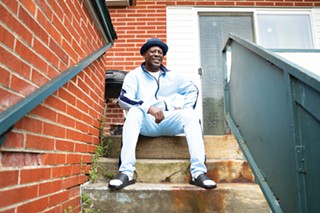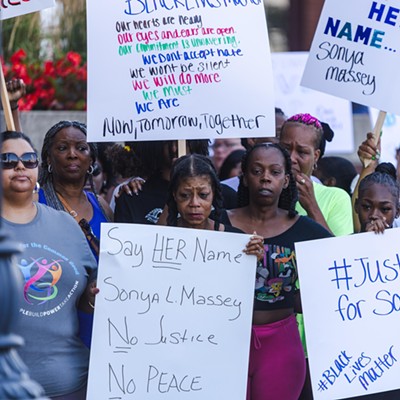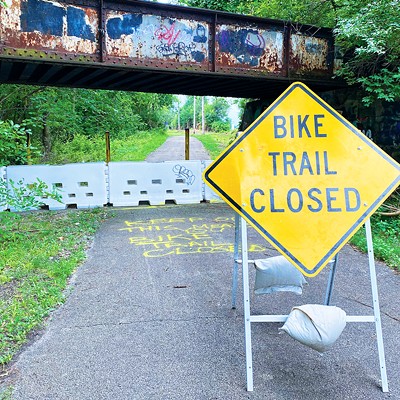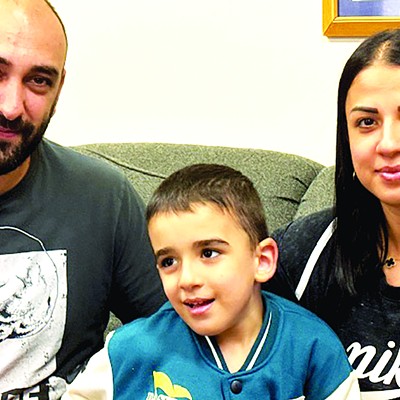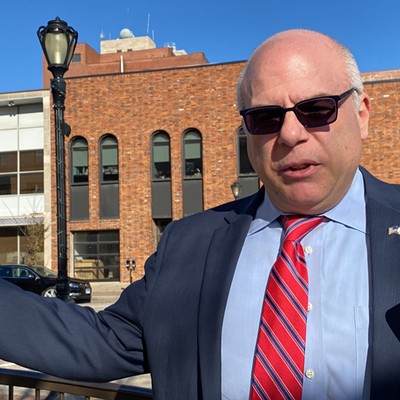Adrian Palmer takes pride in his modest, immaculate apartment.
"I live a clean, peaceful life," the 59-year-old Chicago native said.
After years of living on the streets of Chicago and Freeport, depending on girlfriends' homes in northern Illinois for shelter and completing several stints in prison, Palmer credits a Springfield social service agency for helping him secure and maintain stable housing the past three years.
"I put in a lot of work, and I'm grateful to them," the divorced father of six children and recovering crack cocaine user said of the staff at Helping Hands of Springfield.
Palmer, who previously worked jobs elsewhere in the state in construction and a hospital dietary department, said he avoided a return to homelessness thanks to a "rapid rehousing" program at Helping Hands. He moved into his Springfield apartment about the time rental assistance and case management services, which were invaluable to him, received a boost in federal funding in Springfield and nationwide during the first year of the COVID-19 pandemic.
Pandemic-related federal dollars continue to have an impact as advocates in Sangamon County realign the way they try to reduce homelessness. The goal is to change the focus from emergency shelter to a housing-first model that shortens shelter stays enough so the number of unhoused people approaches what advocates call functional zero.
Federal COVID-19 relief money is paying for an $8.2 million renovation in an unoccupied section of a building in the 2200 block of South Dirksen Parkway that houses the Sangamon County Juvenile Detention Center and Regional Office of Education. The section will be rented to Helping Hands for a 141-bed facility that will put its homeless shelter and housing programs under one roof.
The new site also will fold in what's currently offered by a 75-bed overflow shelter site now owned by the city of Springfield and operated by the Salvation Army at 221 N. 11th St.
The 11th Street site is expected to remain open until Helping Hands moves operations to the new facility on Dirksen, which is expected to be completed in January.
COVID-19 relief dollars also have funded an increase in subsidized housing vouchers through the Springfield Housing Authority. Palmer received one of those vouchers, reducing what he owes for monthly rent from $550 to $194.
The state has increased its commitment to tackling the problem. An $85 million increase for homeless services in the state fiscal year budget that began July 1 will funnel $1.2 million to Springfield, according to Josh Sabo, executive director of Heartland HOUSED, a new nonprofit working to help carry out the plan. That money will create 53 more slots for formerly homeless people needing rapid rehousing and 27 more slots for people needing more intensive case management, in settings known as "permanent supportive housing," he said.
The funding increases dovetail with Springfield and Sangamon County's 2022-2028 Strategic Plan to Address Homelessness.
"I think there are a lot of really important things coming together," Sabo told Illinois Times.
The need to create 765 more units of safe housing that people who are homeless can afford is one of the primary five-year goals set by the strategic plan. About 400 of those units would be for permanent supportive housing. The rest would be for more short-term housing slots.
The 27-page document, finalized in fall 2022, was the product of a $160,000 study that involved the city of Springfield, Sangamon County, the Heartland Continuum of Care and several nonprofits, including Memorial Health, HSHS St. John's Hospital and the housing authority.
The problem
The report said 264 people are homeless in Sangamon County on any given day. That number includes people living on the street or staying in emergency and transitional shelters, but not those who may be temporarily living with friends or relatives. Without changes in the system that cares for them, 746 will enter the system every year and 561 will leave the system, according to the report. That means the homeless population will continue to experience a net growth of about 155 people annually.
Many Springfield-area residents think they encounter the homeless every day when they see people holding cardboard signs on street corners and asking for money. It's unclear how many of the panhandlers actually are homeless, or whether they consider panhandling a job or a way to support a drug habit, because many have never used existing shelters or other services for the homeless, according to officials at area nonprofits.
Officials said another misconception about the homeless is that they all have mental illness. Local counts of the homeless indicate about a third have chronic mental health issues, but advocates said many people who are homeless can live on their own with guidance, as well as counseling and treatment to deal with previous emotional trauma, and short-term financial assistance.
"Sometimes you need a cheerleader," said Laura Davis, executive director of Helping Hands. "They don't need anybody to enable them. They don't need people to do it for them, but they need somebody there, kind of keeping them on task."
Factors contributing to the rise in homelessness include poverty, inflation and income inequality, which refers to the shrinking middle class and growing gap between upper- and lower-income households, Sabo said.
Money is key to the proposed solutions, he said. Nonprofits in the community currently receive more than $1 million per year from federal, state and philanthropic sources, but $2 million more is needed to expand and maintain rapid rehousing and supportive housing services and make a serious dent in the overall problem, he said.
The additional $1.2 million from the state funding expansion, if maintained, would make up about half of the increase needed. The other half may require an annual fundraising effort, Sabo said.
Such a task would be a "tremendous challenge," he said, "but it will take that type of effort to close that funding gap."
In the short term, some of the new money could come from part of the $2.4 million in American Rescue Plan funds allocated to the city of Springfield for households experiencing homelessness and housing instability. Plans for those dollars haven't yet been finalized.
The potential solutions
Several high-profile pieces of the puzzle for housing and related social services are being put into place, but not without controversy.
A 22-unit permanent supportive housing apartment complex at 3526 S. Park Ave., known as Park Avenue Residences, is expected to open in October. The two-story, three-building complex was constructed with almost $6 million in state and federal funding from the Illinois Housing Development Authority and from Helping Hands, which received its $800,000 share from federal funds appropriated by the Springfield City Council.
Built by Windsor Homes, the site was opposed by about 80 neighborhood residents who signed a petition calling for denial of a zoning change in 2021. At the time, Windsor President Mike Niehaus told the City Council that he planned to construct market-rate, privately owned apartments.
Those plans changed, he said, when Helping Hands approached him after the zoning change was granted, and neighbors' opposition intensified. A nonprofit affiliated with Helping Hands, known as Deerfield Reserves, will own the site, and Helping Hands will lease all of the units for their formerly homeless clients, Davis said.
Neighbors have said they worry about increased traffic along Park Avenue that the project will bring. The two-lane, dead-end road has no sidewalks and is not near a bus stop. Neighbors said they worry that Helping Hands clients will be walking around in cold weather to get to mass transit or appointments.
But Helping Hands officials said caseworkers will transport clients to counseling appointments, doctor's visits and grocery stores. Most clients aren't expected to have cars. All will receive intensive case management and will be required to pay no more than 30% of their income for rent.
Davis said the additional money flowing to Sangamon County for permanent supportive housing won't go to fund Park Avenue Residences.
Case management services there will be funded through a grant from the Illinois Department of Human Services, and funds for leasing will come from federal funds and philanthropic donations, Davis said.
Another potential site for permanent supportive housing is land currently occupied by Sportsman's Lounge at 229 W. Mason St., and adjacent parking lots.
Windsor Homes was scheduled to seek an advisory vote of support Aug. 16 from the Springfield Planning and Zoning Commission for a requested zoning change and zoning variance to allow for construction of a 24-unit apartment complex. Niehaus has declined comment on the project, but Ward 5 Ald. Lakeisha Purchase said Windsor's plans call for the complex to be used by formerly homeless residents who would receive 24-hour supervision and supportive services.
Sabo said both projects bode well for the future of services for this population. He would like to see similar projects completed every year to accommodate a critical need.
The city of Springfield, Sangamon County government and Capital Township government each have pledged $250,000 annualyfor the next five years to support Heartland HOUSED, which supports five full-time staff members and plans to add two more in the coming months.
Helping Hands expanding
The current Helping Hands headquarters at 1023 E. Washington St. has 13,000 square feet. The new site will have 23,000 square feet.
Once the newly renovated space on Dirksen Parkway opens, Springfield, for the first time, will have a homeless shelter where adult clients can be admitted at all hours of the day or night. Clients won't be required to leave at a certain time every morning, and meals will be offered regularly on-site, Davis said.
The environment is expected to make clients more willing to remain at the site to work with staff members on employment options, receive physical and mental health care, and look into future housing arrangements, she said. As a result, the system for serving clients will be more efficient overall, she said.
The expansion in rapid rehousing, designed to provide financial support and case management for up to two years, is "giving them the support that they need to get started and then really kind of watching them to make sure that they maintain that housing long term," Davis said.
Renovations for the Dirksen site received Sangamon County Board approval this summer despite some businesses and residents in the area opposing it. County Board member Vera Small, a Springfield Democrat whose district includes the site, voted no on the project.
Ward 3 Ald. Roy Williams Jr., whose ward includes the site, was the only City Council member opposing a zoning variance and conditional permitted use when the council voted on the issue in January.
Small said she is sympathetic to the plight of the homeless, but her vote reflected the views of her constituents. She said she worries that the adult homeless population will mix with the population of the juvenile detention center, something that supporters of the site said won't happen.
Her constituents also have told her they don't want more homeless people loitering in the area and walking through adjacent neighborhoods. And constituents believe the east side of the city has more than its share of sites serving the disadvantaged, she said.
"I don't think it's going to work. It may work," Small said. "Yes, everybody's worried, but it's a done deal. I don't think it will solve the homeless problem."
The Dirksen site is next to a busy four-lane highway with no sidewalks, and it's 3.5 miles to the southeast of the current Helping Hands headquarters. Davis said Helping Hands will work with the Sangamon Mass Transit District to provide free bus passes and shuttle services throughout the day and evening for homeless clients to travel to and from the site.
Small and Williams said homeless people can't be forced to use buses or shuttles. "They have their own minds," Small said.
Davis said she is confident that clients will become used to the new transportation setup to the Dirksen site.
"It may not run seamlessly in the beginning, but we will always have staff available for community concerns," she said.
Sangamon County plans to buy the current Helping Hands site for $275,000, tear down the building and in its place construct a new $3.5 million garage for the Sangamon Menard Area Regional Transit program. The new SMART site will replace a leased warehouse at 1800 E. Adams St.
County Board Chairman Andy Van Meter, a Springfield Republican who leads the Republican-controlled County Board, said he has worked on solutions to homelessness for years, and he is confident the current strategy will be successful.
Homelessness, he said, "is not just an urban problem. This is a rural problem, as well. This is a problem that affects the whole county."
The Dirksen site will provide some, but not all, of the expanded services that Helping Hands had hoped to provide at the proposed Center for Health and Housing in the 500 block of South 11th Street. That plan fell apart in 2019 because of strong resistance from nearby residential neighborhoods and the Springfield chapter of the NAACP.
Sabo said he hopes the expected success of the Park Avenue project and the new Dirksen Parkway home of Helping Hands will reduce the "not-in-my-backyard" arguments that have prevented homeless service sites from being established in at least five locations in the downtown area, north side and east side since 2006.
Success stories
Officials from Helping Hands and Contact Ministries, two nonprofit organizations that serve the homeless, said housing programs work, and there are plenty of success stories.
Adrian Palmer, the Helping Hands client, said he took a Greyhound bus to Springfield in late 2020, shortly after being paroled from prison, when a friend told him social services were relatively more plentiful and accessible in central Illinois than in the Chicago area.
Palmer served prison time for offenses in Cook, DuPage and Stephenson counties that range from domestic violence to aggravated battery and possession of a controlled substance. He said he has been clean for 20 years after a cocaine addiction. He said some of the crimes he served time for were related to frustration that stemmed from job opportunities he missed out on because of his felony record.
He said he lost custody of his children along the way but has been able to rebuild relationships with some of them since he secured stable housing in a small apartment complex on West Laurel Street. He said he supports himself with odd jobs and Supplemental Security Income benefits associated with a hip injury.
Before the Greyhound bus ride, he said he had "never been to Springfield in my life. It has worked out well for me."
Melanie Pyle, 33, credited Contact Ministries and Tracy Deal, the nonprofit's shelter and rapid rehousing director, with helping her get off the street and into an apartment.
Pyle said she worked as a home health care aid for 12 years and lived in Auburn before developing a methamphetamine and heroin addiction. She ended up getting divorced and putting her 2-year-old daughter up for adoption. She showed up at Contact Ministries, 1100 E. Adams St., in December 2020 after calling the 211 community services phone number, designed to connect people with social service resources.
"I thought my life was over," Pyle said.
She was removed from the shelter there for misbehavior, but Deal, a social worker, allowed Pyle to come back despite being "cussed out" by Pyle on several occasions.
"I would not have thought she would be where she is today," Deal said. "She called me everything but a child of god, but I had to remember that it was the demons from the drugs and all of the things that she was doing that made her at that time who she was."
Pyle eventually went through drug rehabilitation and was able to land a job at Land of Lincoln Goodwill Industries, where she is a warehouse manager. She was able to save up and buy a car, and rapid rehousing funds that Deal obtained through Sangamon County Community Resources for rental subsidies helped her move into her Springfield apartment about a year ago and reduced the rent for 12 months.
Pyle said she is grateful for Contact Ministries. She hopes to return to home health care soon and is able to pay her full rent on her own.
"I am right back to where I was," she said.
Deal said many of the homeless women she works with at Contact Ministries are afraid of failing and need encouragement.
"What you find out is the person that walks in the door is not really the person who they really are," she said. "The reason a lot of them are self-medicating is because of all of the trauma and the things that they have experienced in their lives.
"When I see people smile or see their life change for the better, it just does something to me. I feel joy."
Dean Olsen is a senior staff writer at Illinois Times. He can be reached at [email protected], 217-679-7810 or twitter.com/DeanOlsenIT.

